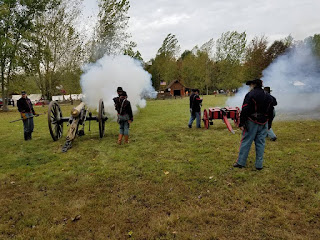While experienced by a much smaller segment of the reenacting community today, the armies were forced to contend with winter conditions each year. Unlike the 20th century where winter combat was common, it was relatively rare to campaign in winter in the 19th. While of the most famous battles occurred at Fredericksburg in December this was an exception to the rule.
Winter quarters were much like any other camp during the course of the war. The daily routine of role calls, drill, parade, drill, eating, drill and so on continued. The pace was slower due to weather however, so the troops would have had more free time. One of the key aspects of that free time was construction of where the soldier would live for the winter.
 |
| A stockade tent |
If the soldiers had more time and materials available, the hut was preferred by the soldiers. The construction of the simple wood hut would vary according to materials available and the skill of the occupants. If it is possible to give a description of a typical hut, I shall attempt to give it.
 |
| Several different styles of construction |
For living conditions, the soldier usually had to fashion his own furniture. A bunk could as be elaborate as a bunk bed or as simple as a board sticking out from the wall. Any tables or chairs would also have been soldier crafted. If the occupants of the hut were at all skilled in construction, the hut would have been a tolerable place to spend the winter. By the time winter was over, any forest within twenty miles could have vanished from a need to supply construction materials and heating fuel.
 |
| Simple hut with stockade tent and chimney |
Jade and myself had occasion to stay in a cabin similar to this in October for a living history event. Temperatures were mid 30s at night through low 50s during the day, damp and windy. The key difference between this cabin and what the soldier's had was the replacement of the fireplace with a potbelly stove. Once the stove was truly going, the cabin was warm enough we often had to leave the door open just to avoid over heating.
Stay warm,
Corporal
Photographs and drawings from the Library of Congress. In order of appearance:
[Unidentified African American soldier in uniform and 10th Corps hat sitting outside shebang]. United States, None. [Between 1863 and 1865] Photograph. Retrieved from the Library of Congress, https://www.loc.gov/item/2016646110/. (Accessed December 30, 2017.)
Forbes, Edwin, Artist. Soldiers' huts in winter camp / E.F. Fredericksburg United States Virginia, 1863. Photograph. Retrieved from the Library of Congress, https://www.loc.gov/item/2004661841/. (Accessed December 30, 2017.)
Forbes, Edwin, Artist. Soldier's hut in winter--Borrowing a chimney. Remington United States Virginia, 1864. Photograph. Retrieved from the Library of Congress, https://www.loc.gov/item/2004661832/. (Accessed December 30, 2017.)
















































